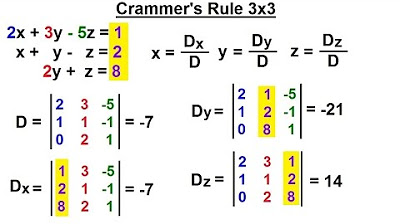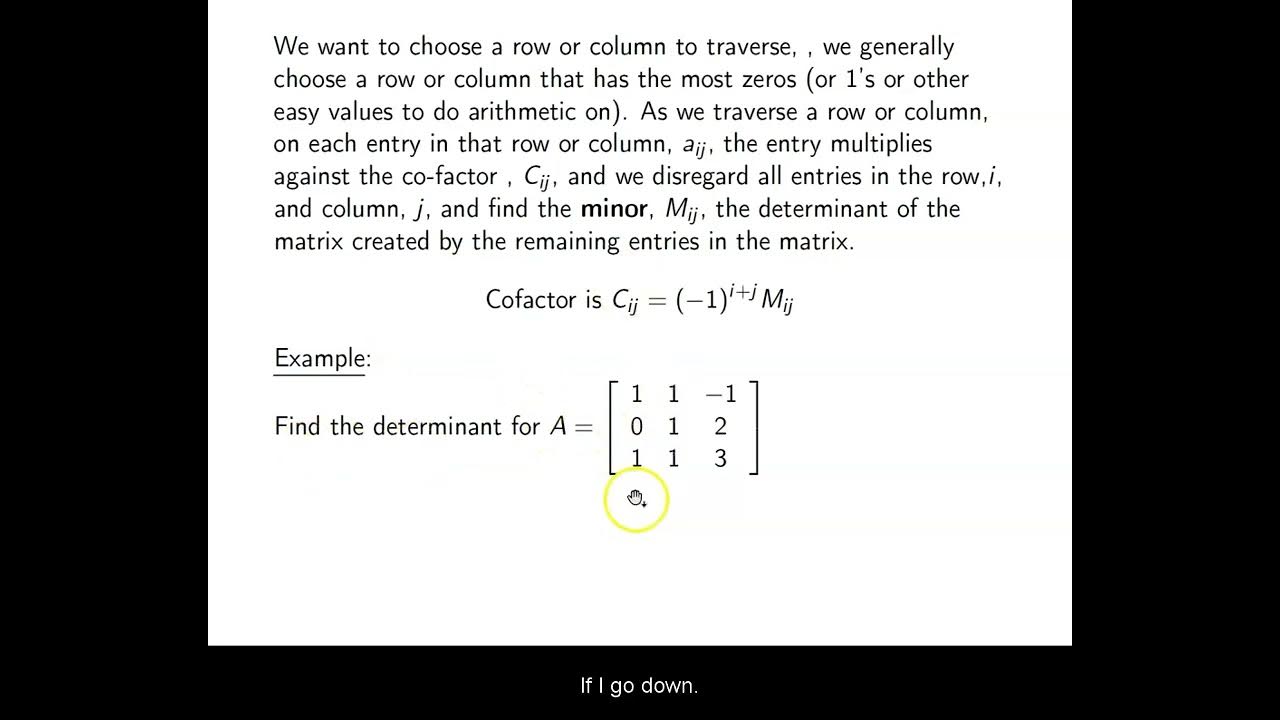PreCalculus - Matrices & Matrix Applications (32 of 33) Using Cramer's Rule to Find x=? y=?
TLDRThe video script introduces Cramer's Rule, a method for solving systems of linear equations using determinants. It explains the process of finding the determinant of the coefficient matrix and how to replace the coefficients with constants to calculate the determinants for x (Dx) and y (Dy). The solution is found by dividing Dx and Dy by the determinant of the coefficient matrix. The script provides a step-by-step example, demonstrating how to apply Cramer's Rule and verify the solution. This method, attributed to Cramer, is an elegant approach to solving linear equations when the number of equations matches the number of variables.
Takeaways
- 📚 Cramer's Rule is a method for solving systems of linear equations using determinants of matrices.
- 🔍 The process involves finding the determinant of the coefficient matrix and determinants of matrices with replaced coefficients for each variable.
- 🌟 The determinant of the coefficient matrix is calculated as the product of the diagonal elements minus the product of the off-diagonal elements.
- 🔢 To find d_sub_x, replace the coefficients of x in the first column with the constants from the equations and calculate the determinant.
- 🔢 To find d_sub_y, replace the coefficients of y in the first column with the constants from the equations and calculate the determinant.
- 📈 The value of x is obtained by dividing d_sub_x by the determinant of the coefficient matrix.
- 📈 The value of y is obtained by dividing d_sub_y by the determinant of the coefficient matrix.
- 💡 The solution to the system of equations is the pair (x, y) derived from the above calculations.
- 🔄 The method can be verified by substituting the calculated values of x and y back into the original equations to check if they satisfy both.
- 📝 The script provides an example where the system of equations is 1x + 2y = 4 and x - y = 2, with the solution being x = 2 and y = -2.
- 🎓 Cramer's Rule is a clever technique introduced by mathematician Gabriel Cramer.
Q & A
What is Cramer's Rule?
-Cramer's Rule is a method for solving systems of linear equations using determinants of matrices. It provides a way to find the values of the variables that satisfy all equations simultaneously.
How does Cramer's Rule utilize matrices?
-Cramer's Rule uses matrices by considering the coefficients of the variables in the equations to form a determinant. This determinant is then used to calculate the values of the variables by dividing it with the determinants of modified matrices where coefficients are replaced by constants.
What is the first step in applying Cramer's Rule?
-The first step is to form a matrix using the coefficients of the variables from the system of linear equations.
How is the determinant of the matrix (denoted as D) calculated?
-The determinant D is calculated by multiplying the products of the diagonals of the matrix and then subtracting them. For a 2x2 matrix with coefficients a, b, c, and d, it is computed as (a*d) - (b*c).
What is the purpose of finding the determinant of the matrix with the x coefficients replaced (denoted as D_x)?
-The determinant D_x is used to find the value of x in the solution. It is calculated by replacing the x coefficients in the original matrix with the constants from the equations and then taking the determinant of the resulting matrix.
How is the value of x determined using Cramer's Rule?
-The value of x is determined by dividing D_x (the determinant of the matrix with x coefficients replaced) by D (the determinant of the original matrix).
What is the purpose of finding the determinant of the matrix with the y coefficients replaced (denoted as D_y)?
-The determinant D_y is used to find the value of y in the solution. It is calculated by replacing the y coefficients in the original matrix with the constants from the equations and then taking the determinant of the resulting matrix.
How is the value of y determined using Cramer's Rule?
-The value of y is determined by dividing D_y (the determinant of the matrix with y coefficients replaced) by D (the determinant of the original matrix).
How can you verify the solution obtained from Cramer's Rule?
-To verify the solution, substitute the values of x and y back into the original equations and check if both equations are satisfied. If the left-hand side equals the right-hand side for both equations, then the solution is correct.
What are the limitations of using Cramer's Rule?
-Cramer's Rule is most suitable for systems of linear equations with two or three variables. It becomes computationally intensive for larger systems, and it cannot be used for systems with inconsistent or dependent equations.
What is the significance of the determinant in Cramer's Rule?
-The determinant plays a crucial role in Cramer's Rule as it is used to find the unique solution for the system of linear equations. If the determinant of the coefficient matrix is non-zero, the system has a unique solution. If it is zero, the system may be dependent or inconsistent, indicating no solution or infinitely many solutions.
Outlines
📚 Introduction to Cramer's Rule
This paragraph introduces Cramer's Rule, a method for solving systems of linear equations using determinants. It explains that unlike matrix methods, Cramer's Rule involves calculating determinants of matrices to find the values of variables that satisfy the given equations simultaneously. The explanation begins with finding the determinant of the coefficient matrix and proceeds to describe how to find the determinants for specific variables (x and y) by replacing the coefficients with constants from the equations. The process of finding the values for x and y using the determinants is outlined, emphasizing the importance of the determinant in determining the solution to the system of equations.
Mindmap
Keywords
💡Cramer's Rule
💡Determinants
💡Linear Equations
💡Matrices
💡Systems of Equations
💡Coefficients
💡Diagonal Numbers
💡Constants
💡Intersection Point
💡Substitution
💡Ratio
Highlights
Introduction to Cramer's Rule for solving systems of linear equations.
Cramer's Rule utilizes determinants, a method related to matrices.
The solution is found at the intersection point of two lines represented by the equations.
To find the x value, calculate the determinant of the matrix with x coefficients replaced by constants, divided by the determinant of the coefficients matrix.
For the y value, replace y coefficients with constants in the matrix and calculate the determinant, then divide by the coefficients matrix determinant.
The determinant of the coefficients matrix is calculated by the product of the diagonal elements minus the product of the off-diagonal elements.
Example matrix provided with coefficients 1, -1, 2, and n.
The determinant calculation results in the value of 3 for the coefficients matrix.
To find d sub x, replace the first column's x coefficients with constants from the equations.
The determinant for d sub x results in the value of 6.
For d sub y, replace the y coefficients with constants, yielding a determinant of -6.
The value of x is found to be 2 by dividing d sub x by the coefficients matrix determinant.
The value of y is determined to be -2 by dividing d sub y by the coefficients matrix determinant.
Verification of the solution by substituting x and y values back into the original equations.
Cramer's Rule is a clever method for solving systems of linear equations using determinants.
Transcripts
Browse More Related Video

Solving Systems Using Cramer's Rule

Cramer's Rule - 2x2 Linear System

PreCalculus - Matrices & Matrix Applications (33 of 33) Using Cramer's Rule to Find x=? y=? z=?

PreCalculus - Matrices & Matrix Applications (28 of 33) Solving Sys of Linear Eqn with Inverse

Ch. 10.6 Determinants and Cramer's Rule

Cramer's Rule - 3x3 Linear System
5.0 / 5 (0 votes)
Thanks for rating: